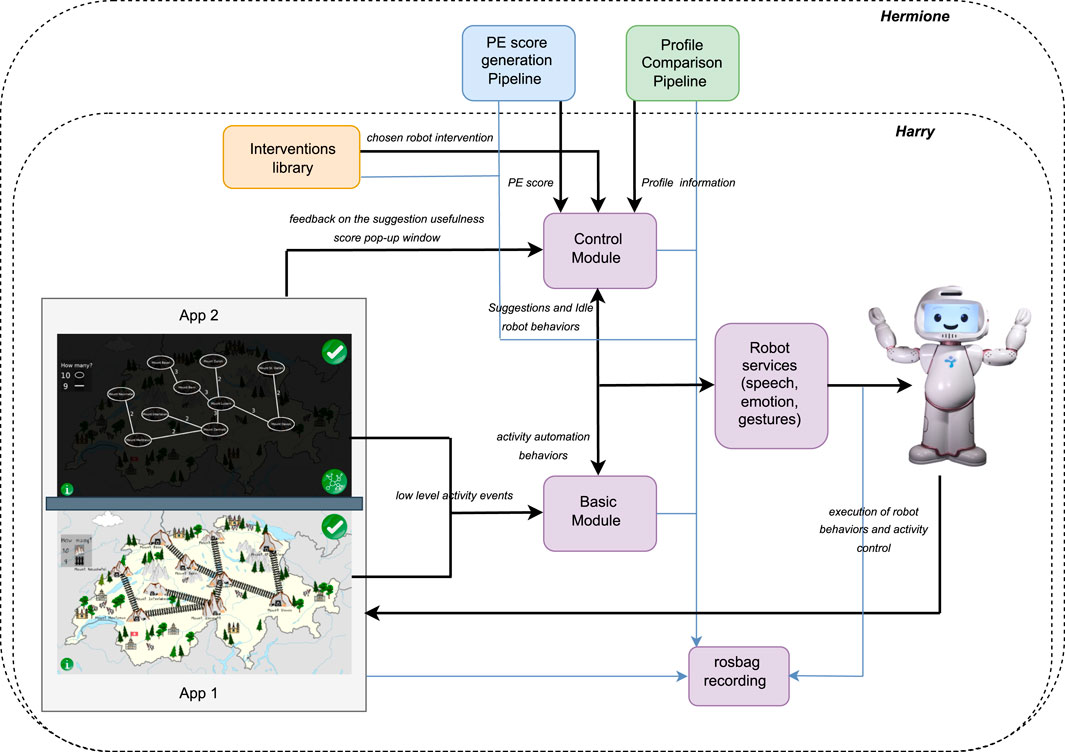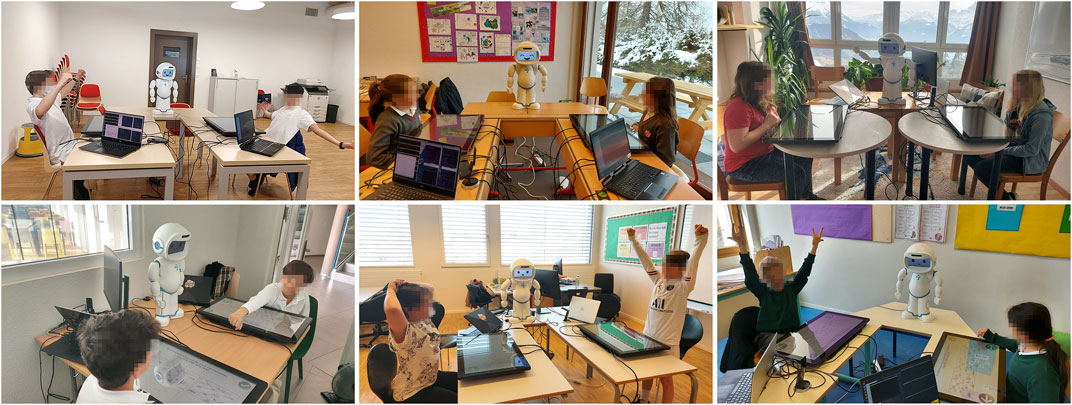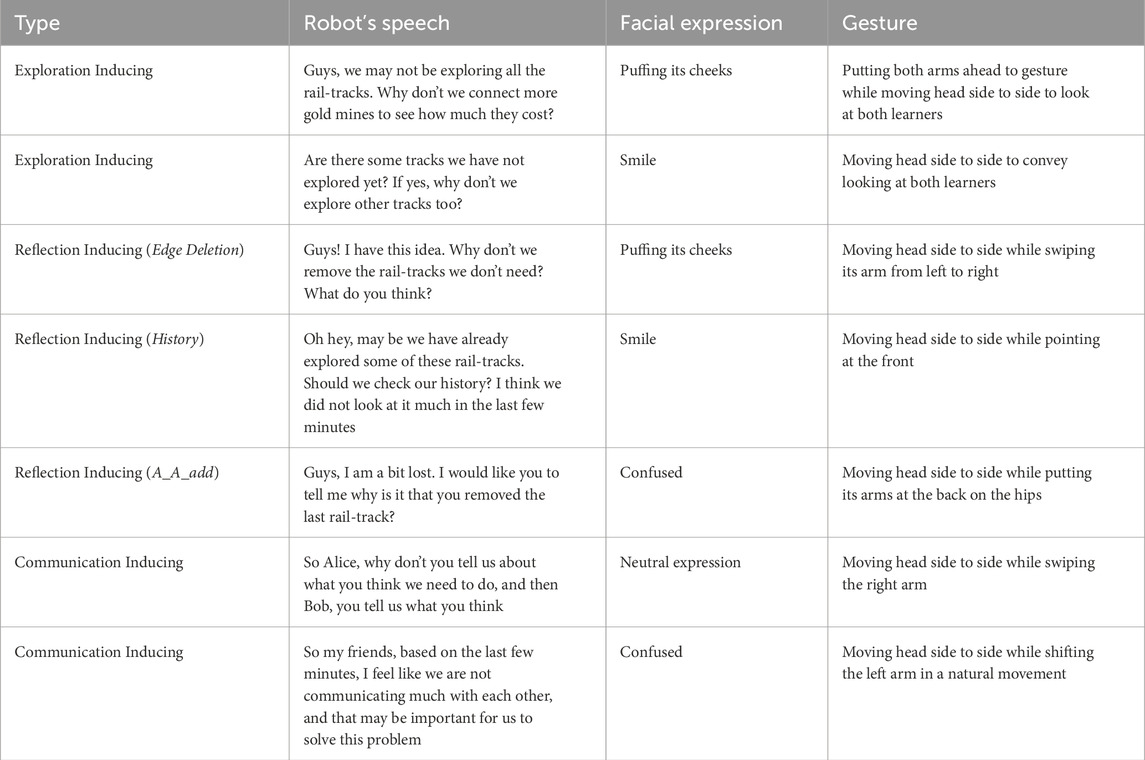- 1Chair of Human-Centered Artificial Intelligence, University of Augsburg, Augsburg, Germany
- 2Computer Human Interaction for Learning and Instruction Lab, École Polytechnique Fédérale de Lausanne (EPFL), Lausanne, Switzerland
- 3Socially Assistive Robotics with Artificial Intelligence Lab, Karlsruhe Institute of Technology, Karlsruhe, Germany
When designing social robots for educational settings, there is often an emphasis on domain knowledge. This presents challenges: 1) Either robots must autonomously acquire domain knowledge, a currently unsolved problem in HRI, or 2) the designers provide this knowledge implying re-programming the robot for new contexts. Recent research explores alternative, relatively easier to port, knowledge areas like student rapport, engagement, and synchrony though these constructs are typically treated as the ultimate goals, when the final goal should be students’ learning. Our aim is to propose a shift in how engagement is considered, aligning it naturally with learning. We introduce the notion of a skilled ignorant peer robot: a robot peer that has little to no domain knowledge but possesses knowledge of student behaviours conducive to learning, i.e., behaviours indicative of productive engagement as extracted from student behavioral profiles. We formally investigate how such a robot’s interventions manipulate the children’s engagement conducive to learning. Specifically, we evaluate two versions of the proposed robot, namely, Harry and Hermione, in a user study with 136 students where each version differs in terms of the intervention strategy. Harry focuses on which suggestions to intervene with from a pool of communication, exploration, and reflection inducing suggestions, while Hermione also carefully considers when and why to intervene. While the teams interacting with Harry have higher productive engagement correlated to learning, this engagement is not affected by the robot’s intervention scheme. In contrast, Hermione’s well-timed interventions, deemed more useful, correlate with productive engagement though engagement is not correlated to learning. These results highlight the potential of a social educational robot as a skilled ignorant peer and stress the importance of precisely timing the robot interventions in a learning environment to be able to manipulate moderating variable of interest such as productive engagement.
1 Introduction
Social educational robots are gaining momentum because of the advantages and impact they bring over software systems thanks to their physical and social abilities as an embodied agent. Current applications envision the robot to fill roles such as tutor (Kennedy et al., 2016; Ramachandran et al., 2019; Donnermann et al., 2022), peer (Baxter et al., 2017; Kory-Westlund and Breazeal, 2019), mediator (Gillet et al., 2020; Tozadore et al., 2022) or even tutee (Lemaignan et al., 2016; Pareto et al., 2022) and span diverse learning scenarios such as mathematics (Ligthart et al., 2023; Smakman et al., 2021; Hindriks and Liebens, 2019), computational thinking (Nasir et al., 2020; Stower and Kappas, 2021), second language learning (Gordon et al., 2016; van den Berghe et al., 2019) or early language learning (Kanero et al., 2018), story telling (Elgarf et al., 2022b; a) and even handwriting (Chandra et al., 2019; Tozadore et al., 2022).
Simply put, the ultimate aim of social educational robots is to improve the learning gain of the students. The traditional, straightforward approach to achieve this goal is to endow the robots with the domain knowledge needed to understand students’ actions and enhance their learning gain. In contrast to general knowledge, domain knowledge is the knowledge of a specialized field and context. One way for a social robot to acquire domain knowledge is via interacting with its environment through trial and error, e.g., relying on a reinforcement learning framework. While recent advancements in deep learning reassure about its potential for autonomous learning on well-defined problems (Sarker, 2021), enabling robots to autonomously acquire domain knowledge in academic subjects that can be later used in interactions with humans is still an open challenge. Even more challenging is to endow AI/robots with the ability to learn how humans acquire knowledge of academic subjects, which is necessary to effectively support human learners in the learning process.
An alternative, more practical but less elegant, method to endow robots with domain knowledge envisions the researchers to simply equip the robot with all the relevant knowledge about the learning problem at hand. This can be done in an offline manner (which is usually the case), for example, in (Ramachandran et al., 2019; Stower and Kappas, 2021; Norman et al., 2022; Ligthart et al., 2023) or in an online manner (Senft et al., 2019). While promising, especially the latter, this solution also presents some drawbacks. In addition to the fact that such robots, by design, are not easily portable from one activity to another without major alterations, the domain knowledge itself is also usually heavily contextualized, typically due to the use of a specific learning platform (Senft et al., 2019; Norman et al., 2022). Hence, the knowledge provided in this manner is typically not only limited to one particular domain, but also one particular learning scenario and paradigm within that domain. As a consequence, manually-programmed social educational robots with only domain knowledge require a significant amount of work, for a limited usability.
Building on research coming out of the learning analytics and psychology communities (Wolters et al., 1996; Fredricks et al., 2004; Kardan and Conati, 2011; Deci, 2017), roboticists are pursuing alternate designs for social educational robots, that seek to bypass the problem of mastering domain knowledge. For example, research has shown that engagement and rapport (particularly during collaborative activities) between the students positively impacts learning (Brown et al., 2013; Chi and Wylie, 2014; Leite et al., 2014; Gordon et al., 2016; Olsen and Finkelstein, 2017; Madaio et al., 2018; Ligthart et al., 2020). Focusing on these constructs thus still allows to follow learning (albeit under an assumption that there is a directly proportional relationship between the modelled construct and learning) without requiring vasts amount of domain knowledge. While these constructs are still known to be influenced, to some extent, by the context, core characteristics could remain indicative over multiple, similar, learning contexts. For example, speech behaviours indicative of conflict resolution and mutual regulation, markers of good collaboration, i.e., collaboration behaviors that help with learning (Blaye, 1988; Schwarz et al., 2000), and in extension markers indicative of student engagement that is conducive to learning in a collaborative setting, can transfer across two collaborative learning tasks with very different underlying learning contexts. Robots relying on these constructs to monitor learning could thus be relatively more versatile and portable.
State-of-the-art methods, typically working post hoc, for the modelling of such domain-agnostic constructs quite surprisingly do not take the learning gain into account (Lytridis et al., 2020). For example, the very common approach of having expert coders rate synchrony or engagement in pre-recorded data, for example, in (Leite et al., 2015; Engwall et al., 2022), to build a training set for ML methods, typically neglects whether, and to what extent, the students ended up learning and could thus lead to incomplete and possibly misleading notions of engagement, synchrony, etc. This neglect can become especially problematic in open-ended activities where exploring, failing, reflecting and finally exploiting the knowledge acquired from all these activities is an essential part of the learning process. In such settings, students’ performance in the learning activity, a more visible phenomenon to the expert coders, does not necessarily translate into their learning (for example, as shown in (Nasir et al., 2020)). A robot tracking and aiming to maximising a construct which is not intrinsically correlated with learning, especially in contexts where the relationship between behaviour and learning is multi-faceted and complex, might thus end up achieving the same performance of one that acts randomly.
In an attempt to contribute to solving this limitation, in previous works we introduced the concept of Productive Engagement (PE) (Nasir et al., 2021a; c), an engagement metric that is construed on students’ observable behaviours and positively correlated with learning gain which, in simple words, can be thought of as the engagement that is conducive to learning. For this type of engagement, we look at both social and task-related student behaviors, as further explained in (Nasir et al., 2021a) which is a common distinction made in HRI (Corrigan et al., 2013; Oertel et al., 2020) particularly in learning settings (Zaga et al., 2015; de Haas et al., 2022). Building on the concept of Productive Engagement, in this paper we propose a robot intervention scheme that tries to reconcile the efficacy of solutions relying only on domain knowledge with the portability of solutions relying on domain-agnostic knowledge.
Such a robot will be able to adequately assess the students’ Productive Engagement, on the basis of the students’ learning profiles such as interactive action patterns as well as their speech quantity and quality, and use this information in a way that will allow it to interact with the students in a helpful-towards-learning manner. This intervention scheme yields a robot which does not fit in the classical roles of tutor, peer or tutee, which are typically defined on the basis of the different level of domain knowledge the robot possesses.
A robot relying on Productive Engagement (and only on it) to drive its interventions, possesses no direct domain knowledge, and a certain amount of knowledge of the student behaviours conducive to learning: we term such a robot a skilled ignorant peer. Concretely, such a robot is clueless as to how to solve a problem, but knows what behaviours are likely to help the students learn, and thus find said solution by themselves. Figure 1 displays the depth of domain knowledge possessed by the robot on the vertical axis and the depth of knowledge it possesses about students’ behaviour that are conducive to learning on the horizontal axis. A number of examples of skilled ignorant peer social educational robots can already be found in the literature. One example is a robot that perceives and tries to influence the affective states of the children to provide social support based on the assumption that being in a certain affective state will help improve learning, for example, in a second language learning scenario or a chess playing scenario with children in (Leite et al., 2014; Gordon et al., 2016) respectively, although it is important to notice that the validity of this assumption has not been investigated.
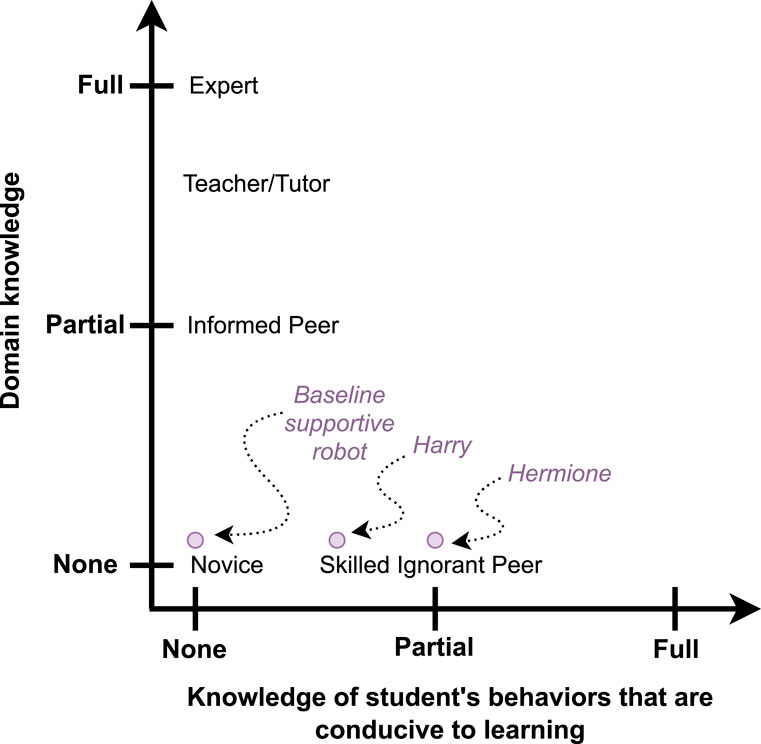
Figure 1. The skilled ignorant peer robots Harry and Hermione, that we propose in this work, placed in the space of domain knowledge and behaviour knowledge. The robot Harry knows what student behaviours could be conducive to learning, while the robot Hermione also knows when to intervene to induce the desired behaviours in the learner. Both robots rely on the concept of Productive Engagement to assess the learner’s state during the interaction.
More concretely, the goal of this work is to explore whether skilled ignorant peer social robots, relying on the construct of Productive Engagement, can be effective for promoting learning. In pursuit of that, we:
1. Between the robot interventions and Productive Engagement (to validate whether the proposed intervention scheme effectively positively influences the students’ behaviour)
2. Between Productive Engagement and the learning gain of the students (to validate whether the students’ behaviour, subject to the real-time interventions of the robot, is still positively correlated with their learning).
To the best of our knowledge, no other work in the literature has formally investigated the two afore-mentioned relationships, i.e., whether or not the robot interventions manipulate the relevant variables of interest which in turn manipulate learning. To better assess the first relationship described above, in this work we propose two skilled ignorant peer social educational robots, referred to throughout the article as Harry and Hermione1.
The reason for designing two robots is the argument that the timing of an intervention is as important as the content of the intervention, when it comes to nudging students towards behaviours expected to conduce to learning. Hence, the difference between Harry and Hermione is the fact that the former is equipped with an intervention scheme that knows what interventions are likely to positively affect students’ behaviour, but calls them randomly, while the latter is equipped with an intervention scheme that seeks to determine when it is best to intervene, and how.
Indeed, previous works in the domain of social educational robots have already emphasized the importance of the appropriate timing of interventions, for example, in the context of suggesting pauses (Ramachandran et al., 2017). The authors compared a robot suggesting children involved in a math activity to make pauses on the basis of a personalization framework with one suggesting to make pauses at fixed intervals and found that the personalized strategy yielded higher learning gains. Then, in (Kennedy et al., 2015), the authors found that caution is needed when designing social behaviors for robots as a too engaging robot, i.e., overly interactive robot, may be distracting for student’s learning gain and eventually counterproductive for the learning process.
In our work, the content of the interventions is shaped by the knowledge on what student behavioural profiles might help in better understanding the learning concepts (that we built in previous works (Nasir et al., 2021c)), while the timing of interventions is shaped by the robot’s ability to detect the absence of the desired student behaviours in real time and trigger the corresponding interventions accordingly. We hypothesize that a robot endowed with this knowledge of when-and-how-to-intervene (Hermione) will not only promote higher learning gains, but also minimize the disruption of the students’ learning process due to unnecessary interventions, compared to another (Harry) which provides randomly picked interventions from the same pool but at fixed times.
2 Materials and methods
In this section, we take the reader in-depth into the background, study design and implementation details. The background and study design sections are written such that the readers can go to the results and discussion sections directly if they wish to skip the implementation details.
2.1 Background
A previous study we conducted using the baseline version of the same platform that we used in the current study, with 92 children and a baseline robot Ron (Nasir et al., 2021c) allowed us to identify three unique sets of student behaviours (in terms of team’s communication behaviour such as speech activity, overlapping or interjecting speech, pauses; their problem solving strategies; facial expressions as well as gaze behaviours), two of which were correlated with higher learning gains. We thus defined: 1) two behavioural profiles for high learning students, respectively denoted as Expressive Explorers and Calm Tinkerers, which are characterized by different problem solving strategies (global vs. local exploration and reflection) but the same communicative behaviour, involving higher speech activity, many interjections and fewer long pauses; and 2) one behavioural profile associated with low learning students, labelled Silent Wanderers, which is characterized by the lack of a clear problem solving strategy, low or no reflection and limited communication, with lower speech activity, few interjections and a higher number of long pauses.
The robot interventions as well as the intervention schemes presented in this paper make use of these findings. More specifically, the aforementioned data corpus, which is publicly available (Nasir et al., 2021b), is used as training dataset in this work for modelling the PE Score, for generating the problem solving strategy profiles of Expressive Explorers and Calm Tinkerers, for defining thresholds, for normalizing incoming data, etc. as will be seen in section 2.3.
2.2 Study design
2.2.1 Study introduction
2.2.1.1 JUSThink-Pro: a collaborative robot mediated game platform
In our study children aged 9–14 interact with JUSThink-Pro, an interactive and collaborative human-human-robot game platform for helping to improve computational thinking skills. JUSThink-Pro is an extension of the baseline version JUSThink (Nasir et al., 2020), which specifically enhances it with (i) the addition of real-time assessment modules that enable the robot to gauge the Productive Engagement state of the children and (ii) the integration of real-time robot interventions, driven by the Productive Engagement analysis. The game is designed as a collaborative problem-based learning activity for the learning goal of gaining conceptual understanding about minimum spanning trees2 (more details about JUSThink are given in (Nasir et al., 2020)).
In this collaborative game, the learning concept is embedded in a fictional scenario set in Switzerland where goldmines, represented as mountains named after Swiss cities, need to be connected by rail-tracks while spending the least amount of money. The game makes players experience two views, with different purposes: the figurative view allows a student to interact with the graph and edit (add or remove) tracks (App one in Figure 2), while the abstract view allows a student to see the cost of existing tracks as well as all of the team’s previous solutions (App two in Figure 2). The two views swap every two edits, allowing the two students composing a team to experience them both equally. A team is allowed to build and submit as many solutions as they want within the 30 min allocated for the game.
In each session, the robot (Harry or Hermione) welcomes the team of two students and provides instructions for the session. This is followed by a pre-test that students perform individually. Then, the children collaboratively play JUSThink-Pro for 30 min, before concluding with the individual post-test and a questionnaire.
2.2.1.2 Experimental protocol
Our experimental protocol includes two conditions designed to assess the effect of the two robots Harry and Hermione on the Productive Engagement and learning gain of the students. Both robots, using the same basic module shown in Figure 2, automate the entire interaction, guide the learners between the various phases of the session, and provide basic motivational feedback as well as the score of each submitted solution. Conversely, the two robots use different control modules to generate their real-time interventions. In the case of Harry, the control module randomly picks at fixed time intervals one among the interventions previously identified (via training data) as correlated with behaviours conducive to learning, from the interventions library. In the case of Hermione, as shown in Figure 2, the control module can rely on additional information about the students provided by the PE score generation pipeline, which tracks in real-time the Productive Engagement state of the students, and the profile comparison pipeline, which monitors their problem solving strategy. Concretely, whenever the PE score of a team goes below a certain threshold, Hermione picks from the same interventions library used by Harry the most appropriate intervention considering the phase of the activity as well as the problem solving strategy at the time followed by the team. The interventions library includes three types of interventions, namely, communication inducing, exploration inducing, and reflection inducing that are meant to induce, as the names suggest, communication between the two team members, an exploration of the available options or reflections on the current and past solutions, respectively. The design of these interventions, which is further elaborated in Section 2.3, is inspired by the learning profiles and analyses presented in our previous work (Nasir et al., 2021c).
Notice how our skilled ignorant peer social educational robots rely on a mix of domain-agnostic information (the PE score and triggering mechanism for robot interventions, as well as the communication-inducing robot interventions) and pseudo-domain-specific information (robot interventions meant to induce exploratory or reflective behaviours that are transversal competencies grounded in the context), and the latter are used within a framework led by the former to support generalizability.
2.2.1.3 Data collection
The study3 took place over 2 months and involved six private international schools across Switzerland. Figure 3 shows students from the various schools interacting with JUSThink-Pro. 136 students (74 male, 62 female) with the age range 9–14 years (median age: 12 years old) interacted with the JUSThink-Pro activity for a total of over 70 h in the form of dyads where each dyad interacted only once with the activity for an hour. This gave us a total of 68 teams, out of which some teams were used for validation of the system’s parameters, and due to missing data, two teams were discarded from the experimental set, giving us a total of 52 teams with 26 teams per condition. We have made the data from this study available at (Nasir et al., 2023).
2.2.2 Evaluation metrics
We evaluated the two robot conditions by looking at (i) the students’ learning gains, (ii) their in-task performance, (iii) their PE scores, (iv) their evaluation of the robot’s competence (both during and after the task in the questionnaire).
For the learning gain, we consider the joint absolute learning gain (T_LG_joint_abs) which is calculated as the difference between the number of questions that both of the team members answered correctly in the post-test and in the pre-test. The reason for using this learning gain is that it captures the shared understanding between the team members that, as established in (Nasir et al., 2021c), is a relevant factor for collaborative learning. The normalized joint absolute learning gain ranges between 0 and 1. For the in-task performance, we consider the last error of the team, intended as the error of the last submitted solution. In the case a team finds an optimal solution (error = 0) the game stops, therefore making last error = 0. The PE score is a quantification of the Productive Engagement state of the team, computed on the basis of quantifiable observable behaviours found conducive to learning. Further details on the real-time computation of the PE score are given in Section 2.3. To evaluate the students’ perception of the robot competence during the task, whenever a robot intervention is triggered, a pop-up dialogue box appears on the screen of each team member, asking them whether they found the suggestion useful or not. Their joint answers compose a suggestion usefulness score with values 1, 0, 0.5 if both found the suggestion useful, not useful, or if they differed in their evaluation, respectively. To evaluate the students’ perception of the robot competence after the end of the task, the students were asked to rate the statements “I think the robot was giving us the right suggestions” (right suggestions) and “I think the robot gave us suggestions at the right time” (right timing) on a five-points Likert scale.
2.2.3 Hypotheses
Concretely, the study aimed to verify the following hypotheses:
• H1: (a) Hermione will lead to higher learning gains as well as (b) a higher number of teams achieving a higher learning gain as compared to Harry.
• H2: Teams that interact with Hermione will display higher Productive Engagement scores compared to the teams that interact with Harry.
• H3: Hermione will be rated higher than Harry on competence.
• H4: Robot interventions will have a positive effect on the PE score in both robot conditions.
• H5: Robot interventions will have the desired effect (increase) on learner behaviours in both conditions.
• H6: The PE score will be positively correlated with the learning gain in both conditions.
With H1, H2 and H3 we look at general variables of interest such as learning gain, productive engagement, and robot perception and seek to assess the effectiveness of the two proposed intervention schemes for skilled ignorant peer social educational robots. H4, H5 and H6 allow for evaluating the two relationships introduced in Section 1: with H4 and H5 we evaluate the relationship between robot interventions (RI) and productive engagement (RI to PE), while H6 evaluates the relationship between the PE score and learning gains (PE to LG).
2.3 Implementation
2.3.1 Robot interventions design
Each robot intervention is comprised of verbal and non-verbal components, where the non-verbal component consists of gestures and facial expressions (some of them are shown in Figure 4). Each intervention is designed to induce one of the behaviours that have been found to be conducive to learning in this activity (i.e., that were displayed by teams labelled as Expressive Explorers and Calm Tinkerers, see (Nasir et al., 2021c) for more details). Specifically, the interventions can be categorized into the following three types:
1. Exploration inducing: these interventions seek to induce the behaviour of Edge Addition in the learners, i.e., nudge them towards exploring different options to connect goldmines to one another.
2. Reflection inducing: these interventions seek to induce the behaviours of Edge Deletion, History (check previous solutions), A_A_add (add back an edge immediately after deleting it), A_A_delete (delete an edge immediately after adding it), A_B_add (add back an edge immediately after your team member deleted it), and A_B_delete (delete an edge immediately after your team member added it). All such actions imply some form of reflection, on the current solution or on the comparison with previous actions and solutions (Nasir et al., 2021c).
3. Communication inducing: these interventions seek to induce Speech Activity and generally communication between the team members.
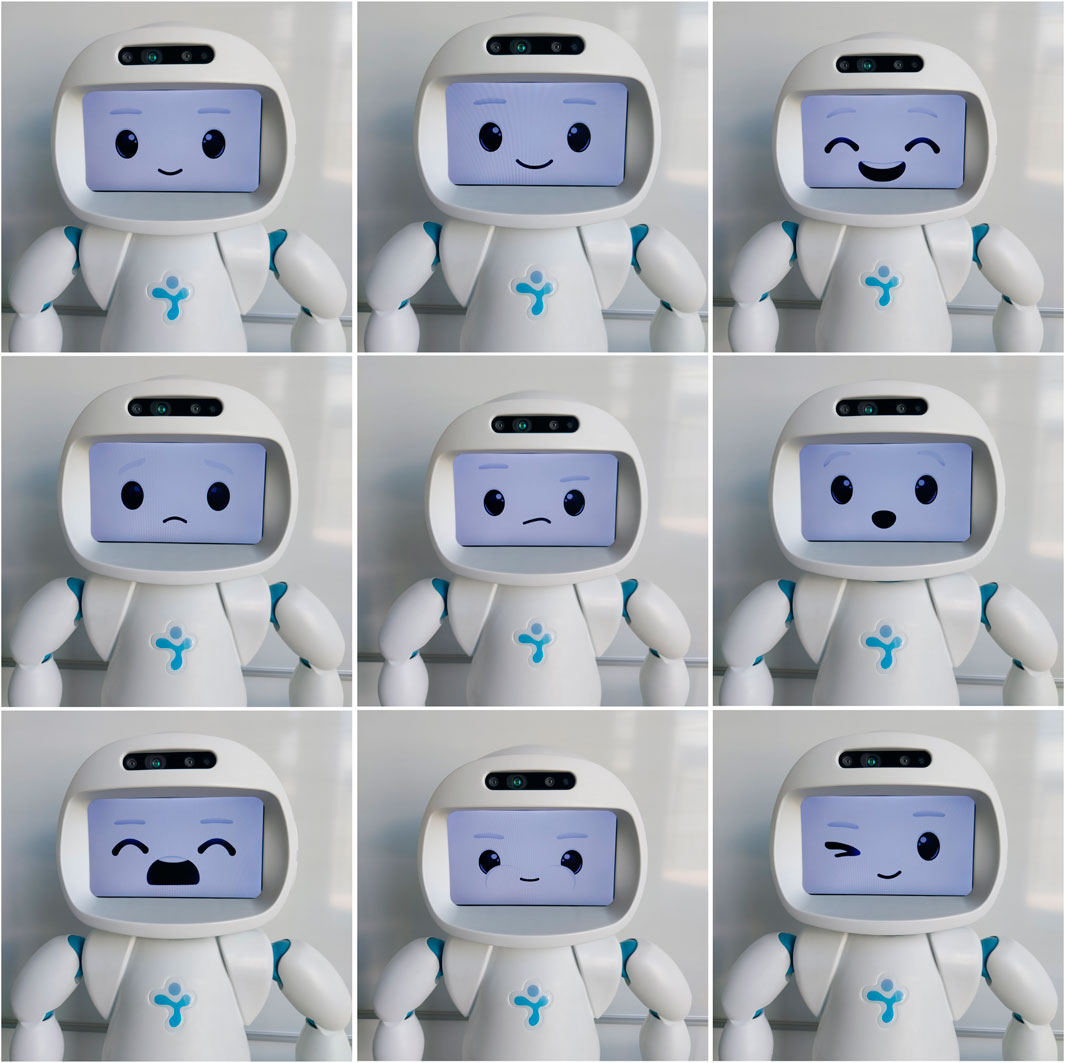
Figure 4. Facial expressions of QTrobot in horizontal order from the top-left corner: neutral, smiling, happy, sad, confused, surprised, bored/yawning, puffing cheeks/being cute, and winking.
It must be noted that, while interventions were designed to explicitly elicit one particular student behaviour, it is not impossible that they also, implicitly induce other behaviours. For example, Exploration inducing and Reflection inducing interventions can indirectly induce an increase in communication between the team members, as a by-product of attracting students’ attention towards a certain action. Similarly, Communication inducing interventions can indirectly induce exploration or reflection actions, as the students share their ideas concerning the next steps or their understanding of the problem. Please note that the robot does not have any idea about what the correct solution is or what would be the best next action to take. Lastly, the style in which each suggestion is conveyed is always supportive and positive. A few examples of interventions are shown in Table 1.
Beside interventions, we also designed a pool of idle, non-verbal robot behaviours, consisting of gestures and facial expressions. These behaviours are randomly triggered every few seconds to give students the feeling of interacting with a lively robot and to provide a more natural feel to the interaction. These behaviours are only executed when no other task of a higher priority is being executed. Examples of idle behaviours include: 1) the robot looking side to side to the two team members, 2) the robot scratching its head, 3) the robot looking confused, 4) the robot folding arms behind its back as if observing the situation.
2.3.2 Productive engagement score
The productive engagement score (PE Score) is designed as a linear combination of the features that we found to be discriminatory between the high-learning teams (henceforth also referred to as “gainers”) and the low-learning teams (henceforth also referred to as “non-gainers”), described in Section 2.1. Discriminant features are “Speech” (S), “Overlap_to_Speech_Ratio” (SO) and “Long_Pauses” (LP). The PE Score is thus computed as a linear combination of these features (with positive or negative sign to ensure that higher values of the PE Score correspond to a higher learning gain) and each feature is weighted by a factor proportional to the contribution of that feature to the variance in the training data4. The PE score is this defined as shown in Equation 1 below:
where
The PE Score can take a value
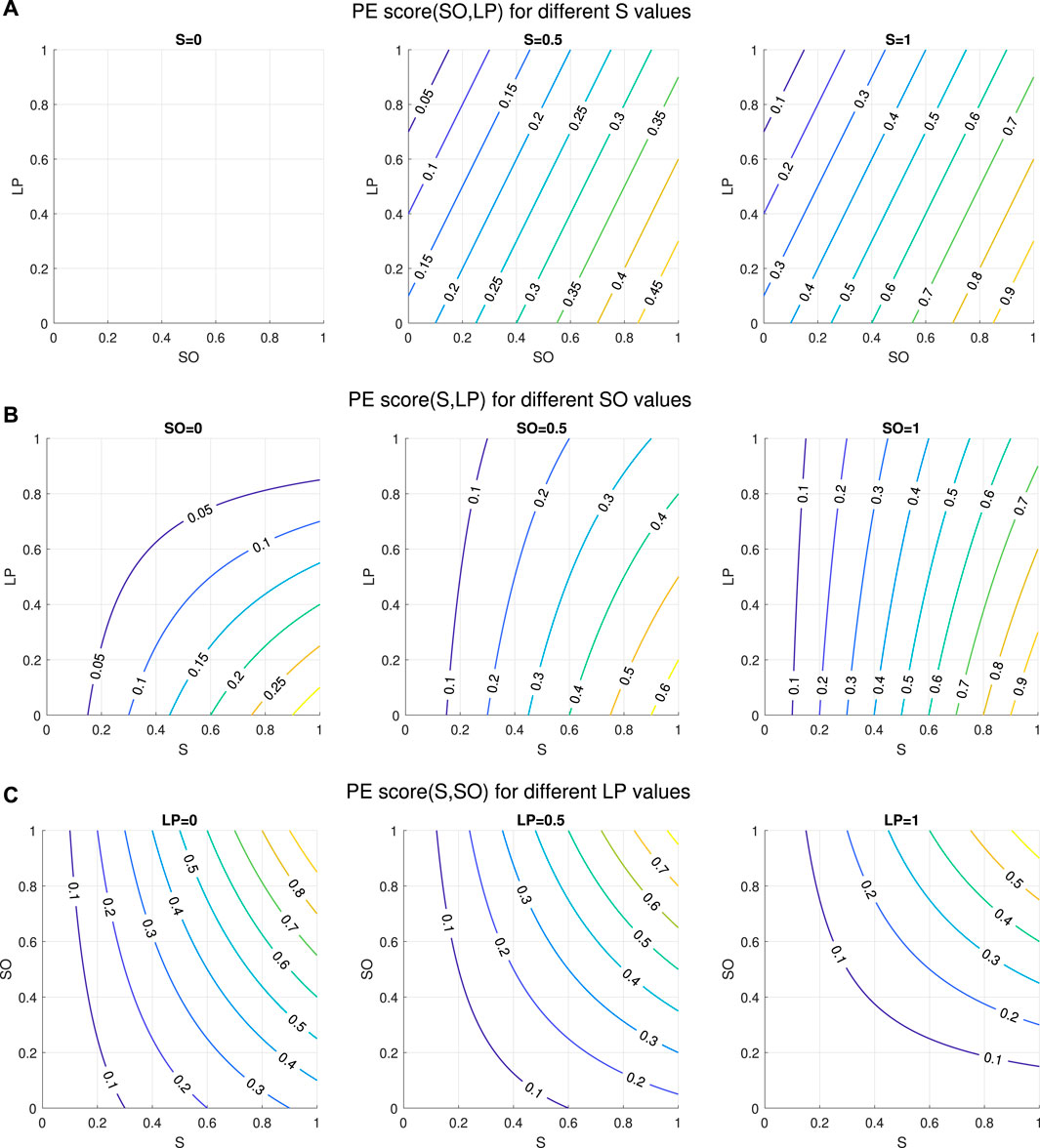
Figure 5. Behaviour of the proposed PE score equation. (A) PE Score when keeping Speech level at 0, 0.5 and 1, respectively. (B) PE Score when keeping the Overlap_to_Speech_Ratio level at 0, 0.5 and 1, respectively. (C) PE Score when keeping the Long_Pauses level at 0, 0.5 and 1, respectively.
To validate the PE score, we consider the training dataset and generate the PE score for every 10-s time window for team interactions with the JUSThink game. We perform several tests to verify if the score can be considered a legitimate form of evaluating the productively engaged state of the teams, i.e., whether the PE Score of high-learning teams is consistently, significantly higher than the PE Score of the low-learning teams. To this end, depending if the assumptions for a parametric test are met, we firstly do an unpaired sample t-test analysis between the averages of the PE Scores and a Wilcoxon rank-sum test between all the points in a PE Score sequence for all the high-learning teams versus the low-learning teams, both of the tests yield statistically significant differences with p-values
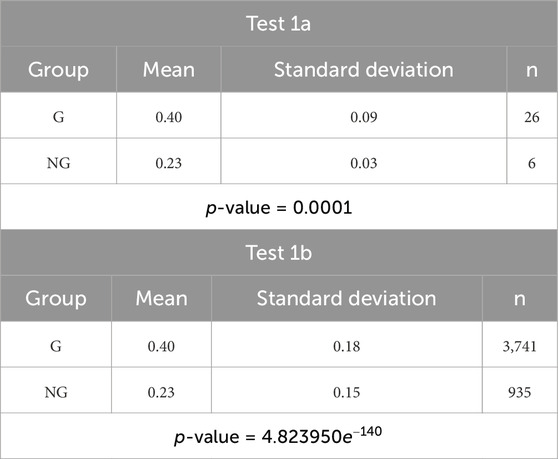
Table 2. Validation test 1: unpaired sample t-test and Wilcoxon rank-sum tests, respectively, for the averages (test 1a) as well as for all the points (test 1b) in PE score sequences of the gainers (G) and non-gainers (NG).
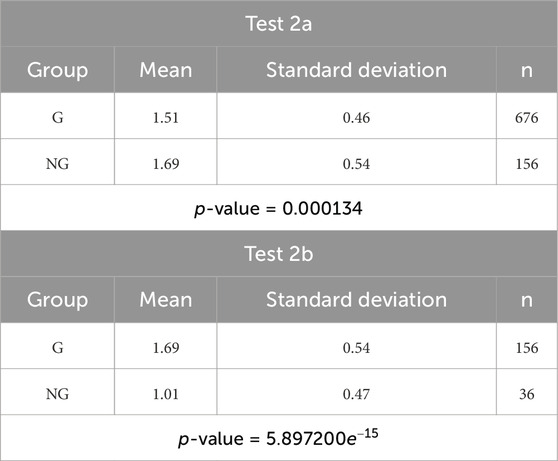
Table 3. Validation test 2: Wilcoxon rank-sum tests between the DTW distances of gainers (G) with the two groups (test 2a) as well as the non-gainers (NG) with the two groups (test 2b).
2.3.3 Generation of the PE score in real-time
For the generation of the PE score in real-time, we employ the pipeline shown in Figure 6A. We must note that in this pipeline, by real-time, we mean that the PE score is updated every 10 s. The audio stream of each team member collected from the laptops’ microphones is analysed by a Voice Activity Detector (VAD) (we use the open-source python wrapper for Google WebRTC VAD5). For every 10 s, the VAD returns a vector for each team member that consists of voiced and unvoiced frames (a vector with 0’s and 1’s). These vectors are then used by our feature extraction module to generate the relevant features such as Speech Activity, Speech Overlap, and Long Pauses (see (Nasir et al., 2021a) for details). The features are normalized with respect to the training dataset. Finally, the PE Score is calculated with these normalized features as described by Equation 1 discussed above.
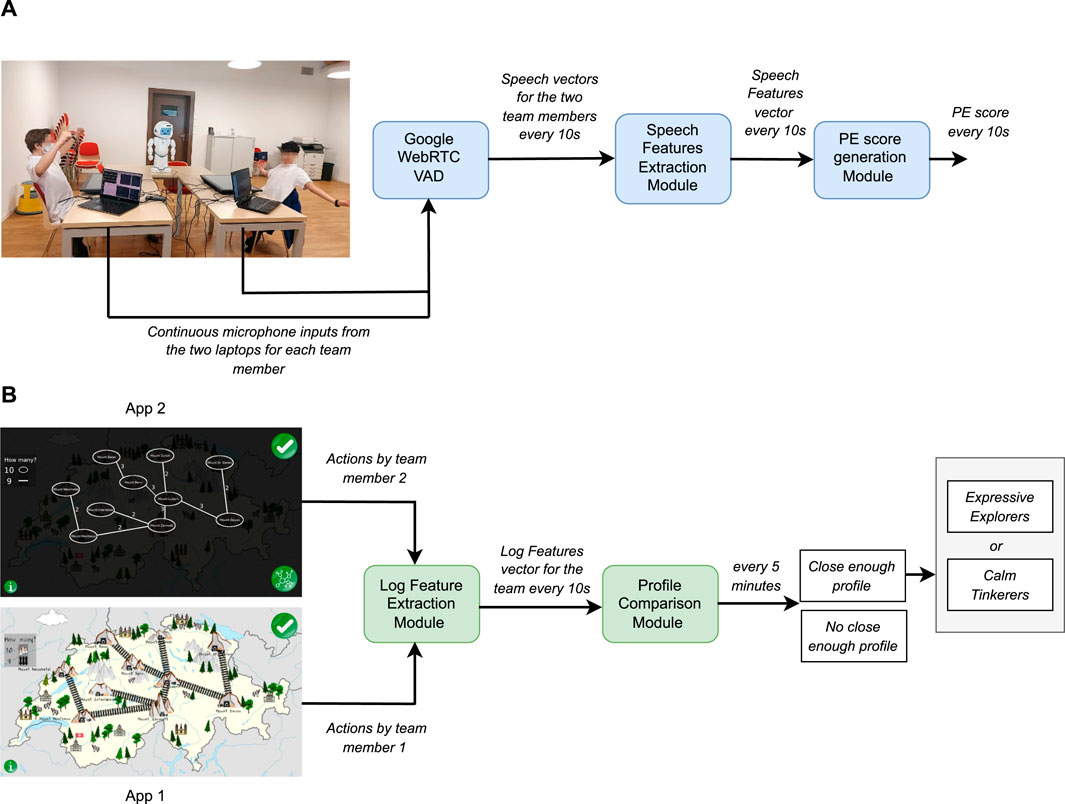
Figure 6. Real time modules for the robot intervention scheme adopted for Hermione. (A) PE score generation pipeline. (B) Profile comparison pipeline.
As introduced in Section 2.2.1 when describing the intervention scheme of Hermione, the PE score of a team is compared against a threshold to determine whether an intervention is needed or not. Equation 2 defines how the threshold is generated:
where
2.3.4 Profile generation and comparison
The profile comparison pipeline can be seen in Figure 6B. Every time a team member performs an action in the JUSThink activity, the application notifies the log features extraction module. For every 10 s, this module generates all the log-related features of relevance, i.e., those corresponding to the behaviours that the robot interventions seek to trigger, such as Edge Addition, Edge Deletion, History, A_A_add, A_A_delete, A_B_add, A_B_delete (see (Nasir et al., 2021b)). The current feature values are then fed to the profile comparison module, that buffers all incoming features until a 5-min timer expires. Then, the module computes the average of each feature until that point in time (on the basis of the values in the buffer and the previous average) and normalizes it with respect to the training data. After that, the module computes the euclidean distance between the normalized log features vector and the reference log features vectors of the Expressive Explorers (EE), and Calm Tinkerers (CT), generated from our training data. This comparison allows to classify the team’s current problem solving strategy as closer to the global exploratory approach followed by the Expressive Explorers, or the local exploratory approach followed by the Calm Tinkerers, or neither of the two.
The comparison unfolds as follows. At each time
In the case that a profile is chosen, the profile comparison module lists the log features from the one in which the incoming vector is farthest to the reference to the one where it is closest. The intuition motivating this choice is that, by triggering a robot intervention aiming to elicit the behaviour corresponding to the farthest feature (i.e., the one that the team is displaying the least), the robot can help the student better align with the problem solving strategy they are already inclining towards, and thus ultimately learn better (the intervention scheme is discussed in detail in Section 2.3.8). In the case none of the distances
The thresholds
where
The rational for computing the profiles 10 min after the beginning of the interaction, and then every 5 min from then on, stems from an analysis of the training dataset. On those data, we noticed that the profiles generated every 5 min after time
Let us walk through an example for profile comparison module. At time
2.3.5 Validation of the thresholds for the profile comparison module and the PE score module
We used the first 19 teams of the 68 teams that participated in our study for validating the thresholds (
2.3.6 Robot architecture
As shown in Figure 2, the robot control architecture of both Harry and Hermione includes two modules: 1) a basic module, and 2) a control module, both sending commands to the robot. The basic module is responsible for automating the entire activity and for handling fixed events occurring during the game play, while the control module is responsible for the selection and triggering of the robot interventions as well as the idle behaviours during the game play. The whole architecture is implemented in ROS.
The automation of the activity includes tasks such as guiding the team through the different stages of the activity pipeline (explained in Section 2.2.1), explaining what each stage requires the students to do, and giving supportive comments during the game play. Every time a solution is submitted by a team, the basic module computes its total cost, which is then verbalized by the robot. In addition to this, the robot randomly reminds the students of the possibility of submitting multiple solutions as well as of the remaining time (the game play is limited to 30 min). The basic module is also responsible for pausing the game (i.e., disabling user events) whenever an intervention is triggered by the control module, to ensure that students pay attention to the robot. For both Harry and Hermione, the basic module receives information from the two apps as well as from the control module and sends commands to the robot via its built-in service controllers. Upon sending a command to the robot, the basic module notifies the control module, to prevent it from concurrently issuing commands to the robot.
While Harry and Hermione use exactly the same basic module, their control modules differ. The control module of Harry implements the intervention selection Algorithm 1, described below in Section 2.3.7. Conversely, the control module of Hermione receives information from the PE score generation module and the profile comparison module and selects interventions following the algorithm described in Section 2.3.8. The two control modules, however, use the same algorithm to generate idle behaviours that is after every 30 s if the robot resources are free, an idle behaviour is executed. For both robots, the control module sends commands to the robot via its built-in service controllers and, upon issuing a command, notifies the basic module to prevent it from concurrently issuing commands. After every robot intervention
2.3.7 Intervention selection scheme of Harry
The intervention selection scheme of Harry, described in Algorithm 1, is rather straightforward: every time a timer set to
Lastly, while Harry does not make use of the outcomes of the PE score generation module and the profile comparison module for the selection of its interventions, their output is still processed and stored for the post-study comparison with Hermione.
Algorithm 1.Intervention Selection Scheme for Harry.
1:
2:
3:
4: Every
5: Pick an intervention
6: Harry executes
7: Wait for 2 min
8: Calculate and store
9: Reset timer
2.3.8 Intervention Selection Scheme for Hermione
Algorithm 2.Intervention Selection Scheme for Hermione.
1:
2:
3:
4:
5: EWMA PE Score
6: if EWMA PE Score
7: Do nothing
8: else if EWMA PE Score
9: if
10: if
11: Sort
12: Set
13: else if
14: Pass
15: end if
16: Pick the first intervention
17: Hermione executes
18: Wait for 2 min
19: Update
20: Set
21: else if
22: if
23: Sort
24: Set
25: else if
26: Pass
27: end if
28: Identify the weakest log action based feature of the matched profile
29: Pick the first corresponding intervention
30: Hermione executes
31: Wait for 2 min
32: Update
33: Set
34: end if
35: end if
The intervention selection scheme for Hermione is described in Algorithm 2. On the basis of the team’s PE score, computed every 10 s by the PE score generation module, the algorithm computes the exponentially weighted moving average (EWMA) of the PE score, over a sliding window of 2 min. This value is chosen to ensure that, as in the case of Harry, at least 2 min pass in between one intervention and another.
The EWMA PE score is then compared to the threshold
Once all interventions associated with the same behaviour have been used (which, however, is quite rare in a 30 min activity), all the flags
where
where t denotes time,
3 Results
We first compare the two robot versions in terms of learning gain, productive engagement, and competence (H1-H3) and then we evaluate the two relationships introduced in Section 1: with H4 and H5 we evaluate the relationship between robot interventions (RI) and productive engagement (RI to PE), while H6 evaluates the relationship between the PE score and learning gains (PE to LG). For our analysis, we use two types of tests: Unpaired Sample t-test whenever the samples are continuous and satisfy the assumptions for a parametric test, and Wilcoxon rank-sum test whenever at least one sample out of two does not satisfy the assumptions for a parametric test and/or is an ordinal variable.
3.1 Comparison between Harry and Hermione (H1-H3)
To evaluate hypotheses H1-H3, we run a Wilcoxon rank-sum test between the two conditions for the aforementioned evaluation metrics for learning gain, and perceived competence; and an unpaired sample t-test for PE score. As shown in Figure 7C, there is no significant difference between students interacting with Harry and those interacting with Hermione in terms of learning gain. Hence, H1(a) is not supported.
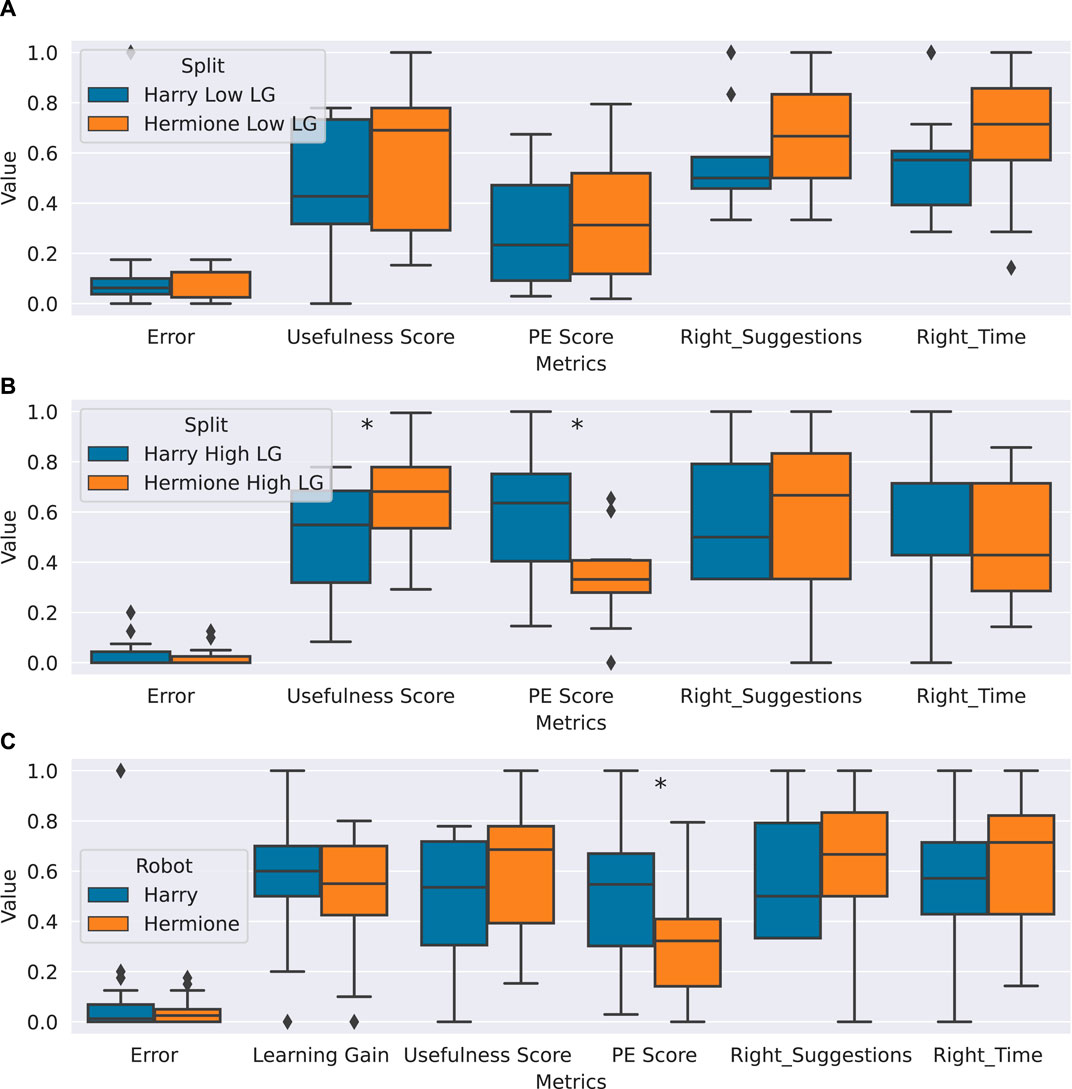
Figure 7. Analysis of hypotheses H1-H3. (A) Comparison between the low learning teams interacting with Harry and those interacting with Hermione, on the evaluation metrics presented in Section 2.2.2. None of the metrics differ with statistical significance. (B) Comparison between the high learning teams interacting with Harry and those interacting with Hermione, on the evaluation metrics presented in Section 2.2.2. The asterisks on the graph denote significant differences on the statistical test (PE score, p-value: 0.003) (suggestion_usefulness score, p-value: 0.05). (C) Comparison between the groups interacting with Harry and those interacting with Hermione, on the evaluation metrics presented in Section 2.2.2. The asterisks on the graph denote significant differences on the statistical test (PE score, p-value: 0.02). For all three sub-graphs, the value on the y-axis indicates where the variables on x-axis for each of the two conditions lie along the range of 0–1.
Furthermore, contrary to our expectations, the Productive Engagement score is significantly higher (p-value: 0.02, H: 2.30) for the teams that interacted with Harry than those who interacted with Hermione. Thus hypothesis H2 is rejected.
Lastly, Hermione’s suggestions were preferred over those from Harry. The suggestion usefulness score is higher for Hermione than for Harry, with marginal significance (p-value: 0.06, H:
3.1.1 High and low learning groups between conditions
In order to investigate H1(b) and better understand the afore-reported outcomes we first verify whether the differences in the Productive Engagement score and the suggestion usefulness score come from a difference in the number of high and low learning teams in the two conditions.
To this end, we calculate the average learning gain (T_LG_joint_abs) of the entire data set (0.559, normalized between 0 and 1) and use a mean split to split the teams in each condition into two groups: one group comprising of teams with high learning gains and the other group comprising of low learning gains. To validate this mean split, we observe via Wilcoxon rank-sum test that indeed the learning gains of the low learning teams are significantly different from the ones of the high learning teams, in both conditions (for Harry, p-value:
Furthermore, we compare the two groups between the two conditions on the evaluation metrics introduced in Section 2.2.2 using Wilcoxon rank-sum tests mainly and unpaired sample t-test for the PE Score. As Figure 7A shows, there is no difference in terms of any metric between the two groups that have low learning gains, i.e., low learning teams behave similarly irrespective of the robot they interact with. Conversely, significant differences are found when comparing the two groups that have higher learning gains, as shown in Figure 7B, which explain the differences in the Productive Engagement score and suggestion usefulness score found in Section 3.1. The teams with higher learning gains in the Harry condition display a significantly higher PE score (p-value: 0.003, H: 3.17) and rate the robot significantly lower on the usefulness of the suggestions (p-value: 0.05, H:
3.2 Correlations between the robot interventions, PE score and learning gain (H4-H6)
To answer the hypothesis H4, exploring the relationship between robot interventions and the PE score, we are first interested in identifying the types of robot interventions that were received by the students in each condition. More specifically, we focus on the high learning teams who interacted with Harry and Hermione, as it is only between these groups that differences surface in terms of PE score and suggestion_usefulness score. Indeed, a Wilcoxon rank-sum test reveals that the high learning teams interacting with Harry received significantly more exploration inducing interventions (p-value: 0.05, H: 1.90) as well as reflection inducing interventions (p-value: 0.002, H: 3.06) compared with the Hermione group while the high learning teams that interacted with Hermione received significantly more communication inducing interventions (p-value:
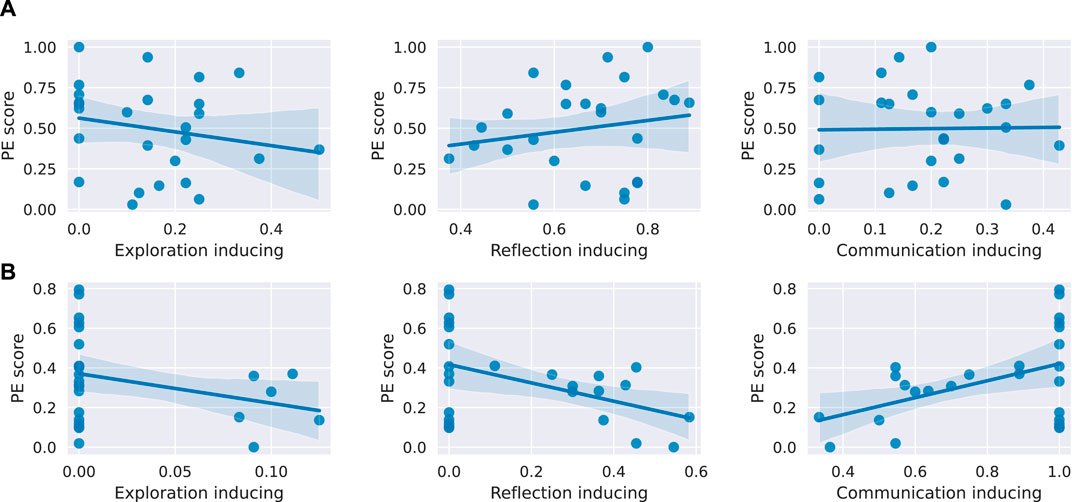
Figure 8. Linear regression between the three intervention types and the PE score for the high learning teams in both conditions. (A) For high learning teams interacting with Harry, none of the intervention types is a statistically significant predictor of the PE score. (B) For high learning teams interacting with Hermione, communication inducing and reflection inducing interventions are statistically significant predictors of the PE score with p-values of 0.02 and 0.02, respectively.
To assess H5, we evaluate the effectiveness of the interventions, i.e., if the corresponding learner behaviour increases in the 2 minutes after the intervention is suggested as compared to the 2 minutes that preceded the intervention. If that is the case, the intervention is considered effective. We can thus compute the percentage of interventions that were effective, for each of the three types of interventions. For both robots Harry and Hermione, while the communication inducing (53% and 48%, respectively) and the exploration inducing (42% and 33%, respectively) interventions are effective in a medium range, very few (6% and 10%, respectively) of the reflection inducing interventions seem to have been effective. Hence, H5 is only partially supported.
Lastly, hypothesis H6 investigates the relationship between the Productive Engagement score and the learning gain T_LG_joint_abs. To this end, we again perform a linear regression analysis with the PE score as the independent variable and the learning gain as the dependent variable. The results are shown in Figure 9. In the case of teams interacting with Harry, the PE score significantly predicts the learning gain (
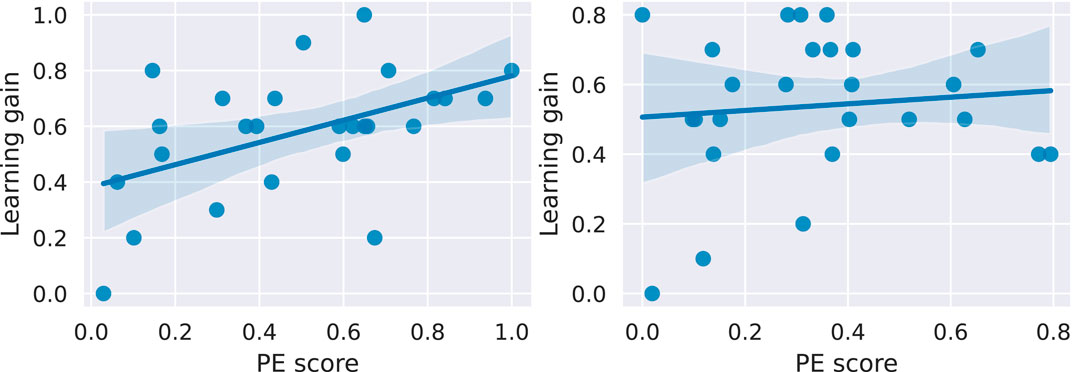
Figure 9. Linear regression between the PE scores and the learning gains of the teams in both conditions. For teams interacting with Harry (left), the PE score significantly predicts the learning gain with a
3.3 Summary
Tying our main findings altogether, both robots induce similar learning outcomes (H1a) and similar level of effective interventions (H5), but teams interacting with Harry display a significantly higher PE Score than those interacting with Hermione (H2). For Harry, a robot that leverages much less information than Hermione, there exists a relationship between the PE Score and the learning gain (H6) and a high number of teams (more than in the case of Hermione) end up with higher learning gains (H1b). However, the PE Score does not seem to be correlated with the interventions of the robot (H4) and the robot’s suggestions are perceived as less useful by the learners (H3). On the contrary, for Hermione, there exists a relationship between some of the robot’s interventions and the PE Score (H4) and the robot’s suggestions are perceived as more useful by the learners (H3). However, there is no correlation between the PE Score and learning gain (H6).
4 Discussion
To interpret our results, we go back to the two sides of the equation that links robot interventions to students’ productive engagement and students’ productive engagement to students’ learning.
In the case of Harry, teams received significantly more reflection inducing and exploration inducing interventions which, although found to induce the desired behaviour 6% and 42% of the times, were not found to impact the PE score in any way. For this, we hypothesize that the timing of interventions, not taken into consideration by Harry, could be extremely crucial to define this relationship. In turn, the PE score was found to be positively correlated with the students’ learning gain. Conversely, in the case of Hermione, teams receive significantly more communication inducing interventions which elicit the desired behaviours 48% of the times and were found to positively affect the PE score. This suggests that a more conscious action selection strategy, i.e., that of Hermione, can indeed significantly influence the variable of interest Productive Engagement, showing the potential of such a skilled ignorant peer robot. However, the PE score of students interacting with Hermione was not found to be correlated with their learning gain. We provide two hypotheses for this: 1) the linear correlation between the PE score and the learning gain holds valid only above a given threshold. Indeed, for teams interacting with Hermione, the PE score is not only significantly lower than the one of those interacting with Harry, but generally lying around low values, with a mean value of 0.33 which is very close to the threshold value
The analysis of the reflection inducing interventions is particularly interesting. While teams that interacted with Harry received significantly more interventions of this type than those who interacted with Hermione, the former seemed unaffected by the interventions, while the latter saw a decrease in their PE score. Considering that, in the case of Hermione, the positive effect of communication inducing interventions on the PE score was counteracted by the negative effect of the reflection inducing ones, this clash might be part of the reasons why no conclusions can be drawn on the link between the PE score and learning gain in the case of Hermione, in addition to the hypotheses mentioned above. The detrimental effect that reflection inducing interventions had on the PE score in Hermione and their general limited effectiveness in inducing the desired behaviours (6% and 10% for Harry and Hermione, respectively) suggest that future studies should particularly refine the content of the reflection inducing interventions to successfully induce the desired behaviours.
To summarize, our results with a skilled ignorant peer social educational robot demonstrate both theoretical and practical implications that we highlight below.
4.1 A perspective shift when modelling subjective constructs
Our modelling of engagement represents a shift towards aligning it with the ultimate goal of student learning, which is the cornerstone of the design of any social educational robot. The practical but naive assumption of a linear relationship between engagement (however measured!) and learning, as our study shows, is incomplete at best. A key goal of this work was to better characterize this relationship and better evaluate it, while concurrently assessing the relationship a robot’s interventions have with such engagement.
We contend that this paradigm shift can be regarded as a fundamental design principle with profound implications for HRI. It offers guidance for modeling and validating subjective constructs such as engagement, rapport, synchrony, collaboration, etc., in educational human-robot interaction settings, emphasizing that these constructs are not endpoints in themselves but rather integral means to achieve the ultimate educational goal.
4.2 Timing matters
One major challenge for social robots in real-world HRI is to initiate communication or provide feedback when it is least disruptive to the interaction at hand. In the specific case of educational social robots, the overarching aspiration is to build a robot that intervenes in a timely manner such that its interventions are least disruptive to the learning process, and most likely to be well received by the students both objectively (as observed in their subsequent behaviour) and subjectively (as rated based on their personal experience). Consequently, our investigation of the effect of robot interventions and their timing on the students’ engagement state, intrinsically tied to learning, and on their perception is a timely contribution. We argue for the inclusion of validation checks in HRI studies where robot behaviours are driven by students’ behaviours (here, embedded in Productive Engagement) to gauge the extent to which the robot interventions manipulate the variables of interest, thereby verifying the reliability of the robot design. For example, in our work, the variable of interest Productive Engagement was not manipulated at all by Harry but it was manipulated in the case of Hermione. Future work can focus on how to leverage this relationship to eventually lead to higher learning.
4.3 Outlook
While the paper demonstrates the potential of using a social educational robot as a skilled ignorant peer in an educational environment, some limitations need to be highlighted and addressed in future work. As a part of idle behaviours, the robot would randomly sometimes scratch it’s head or look confused which could influence the children’s problem solving behaviour when the team is closer to a solution. While we did not directly observe such a situation, this nonetheless is a possibility; hence more careful design and choice of idle robot behaviours should be considered. Then, since all data used in this work were collected at international schools in Switzerland, they refer to a very specific pool of students, coming from a certain economic and social background; hence, any generalization requires further studies. Furthermore, the training data is not balanced in terms of the two classes of gainers and non-gainers.
Similarly, there is a need to apply the framework of Productive Engagement, i.e., the design methodology for an autonomous skilled ignorant peer social educational robot equipped with the concept of Productive Engagement, in contexts other than the JUSThink activity. This would allow us to better understand how the framework generalizes to other tasks and learning activities. For instance, our task relies on a shared visual workspace which has an influence on the possible problem solving strategies and interactions. Other tasks might not have the same characteristics. Therefore, in the future, we would like for this framework to be adopted and evaluated in other HRI learning activities as well as other learning contexts.
Data availability statement
The datasets presented in this study can be found in online repositories. The names of the repository/repositories and accession number(s) can be found in the article/supplementary material.
Ethics statement
The studies involving humans were approved by the EPFL Human Research Ethics Committee (051-2019/05.09.2019). The studies were conducted in accordance with the local legislation and institutional requirements. Written informed consent for participation in this study was provided by the participants’ legal guardians/next of kin.
Author contributions
JN: Conceptualization, Data curation, Formal Analysis, Investigation, Methodology, Project administration, Resources, Software, Validation, Visualization, Writing–original draft, Writing–review and editing. BB: Conceptualization, Investigation, Methodology, Project administration, Resources, Supervision, Validation, Visualization, Writing–review and editing. PD: Funding acquisition, Project administration, Resources, Supervision, Writing–review and editing.
Funding
The author(s) declare that financial support was received for the research, authorship, and/or publication of this article. This project has received funding from the European Union’s Horizon 2020 research and innovation programme under grant agreement No 765955. Open access funding by Swiss Federal Institute of Technology in Lausanne (EPFL).
Acknowledgments
We thank all the school directors, teachers, and students and our colleague, Melissa Skewers, at EPFL who made it possible to conduct this intensive user study. We also thank our colleague Utku Norman who accompanied in the data collection process.
Conflict of interest
The authors declare that the research was conducted in the absence of any commercial or financial relationships that could be construed as a potential conflict of interest.
Publisher’s note
All claims expressed in this article are solely those of the authors and do not necessarily represent those of their affiliated organizations, or those of the publisher, the editors and the reviewers. Any product that may be evaluated in this article, or claim that may be made by its manufacturer, is not guaranteed or endorsed by the publisher.
Footnotes
1The names were chosen by the first two authors, who are avid fans of the Harry Potter books, in a lively and thoroughly enjoyable discussion. The authors argue that, throughout the book series, Harry displays a rather intuitive understanding of what is the right thing to do and spends little time dwelling onto why it is so. Conversely, the know-it-all Hermione always knows what to do, and why, and when. Please note the names are only for us (and the research community hereafter) to refer to different variants. The students are never exposed to the names to avoid any biases. In experimental settings, the robot always introduces itself to all students as QTrobot.
2Let
3Ethical approval for this study was obtained from the EPFL Human Research Ethics Committee (051–2019/05.09.2019).
4Note that a linear combination is one possible way and the most straightforward way but may not be the only way of modelling productive engagement in the form of a PE score.
References
Baxter, P., Ashurst, E., Read, R., Kennedy, J., and Belpaeme, T. (2017). Robot education peers in a situated primary school study: personalisation promotes child learning. PLoS ONE 12, e0178126. doi:10.1371/journal.pone.0178126
Blaye, A. (1988). “Confrontation socio-cognitive et résolution de problèmes,”. Ph.D. thesis (Aix-en-Provence, France: Centre de Recherche en Psychologie Cognitive, Université de Provence).
Brown, L. V., Kerwin, R., and Howard, A. M. (2013). “Applying behavioral strategies for student engagement using a robotic educational agent,” in Proceedings - 2013 IEEE International Conference on Systems, Man, and Cybernetics, SMC 2013, Manchester, UK, 13-16 October 2013, 4360–4365.
Chandra, S., Dillenbourg, P., and Paiva, A. (2019). Children teach handwriting to a social robot with different learning competencies. Int. J. Soc. Robotics 11, 721–748. doi:10.1007/s12369-019-00589-w
Chi, M. T., and Wylie, R. (2014). The ICAP framework: linking cognitive engagement to active learning outcomes. Educ. Psychol. 49, 219–243. doi:10.1080/00461520.2014.965823
Corrigan, L. J., Peters, C., and Castellano, G. (2013). Social-task engagement: striking a balance between the robot and the task. Embodied Commun. Goals Intentions Work ICSR’13 13 (1–7).
Deci, E. (2017). Intrinsic motivation and self-determination. Springer. doi:10.1016/B978-0-12-809324-5.05613-3
de Haas, M., Vogt, P., van den Berghe, R., Leseman, P., Oudgenoeg-Paz, O., Willemsen, B., et al. (2022). Engagement in longitudinal child-robot language learning interactions: disentangling robot and task engagement. Int. J. Child-Computer Interact. 33, 100501. doi:10.1016/j.ijcci.2022.100501
Donnermann, M., Schaper, P., and Lugrin, B. (2022). Social robots in applied settings: a long-term study on adaptive robotic tutors in higher education. Front. Robotics AI 9, 831633. doi:10.3389/frobt.2022.831633
Elgarf, M., Calvo-Barajas, N., Alves-Oliveira, P., Perugia, G., Castellano, G., Peters, C., et al. (2022a). ““And then what happens?” promoting children’s verbal creativity using a robot,” in 2022 17th ACM/IEEE International Conference on Human-Robot Interaction (HRI), Sapporo, Japan, 07-10 March 2022, 71–79.
Elgarf, M., Zojaji, S., Skantze, G., and Peters, C. (2022b). “Creativebot: a creative storyteller robot to stimulate creativity in children,” in Proceedings of the 2022 international conference on multimodal interaction (New York, NY, USA: Association for Computing Machinery), ICMI ’22), 540–548. doi:10.1145/3536221.3556578
Engwall, O., Cumbal, R., Lopes, J., Ljung, M., and Månsson, L. (2022). Identification of low-engaged learners in robot-led second language conversations with adults. ACM Trans. Human-Robot Interact. 11, 1–33. doi:10.1145/3503799
Fredricks, J. A., Blumenfeld, P. C., and Paris, A. H. (2004). School engagement: potential of the concept, state of the evidence. Rev. Educ. Res. 74, 59–109. doi:10.3102/00346543074001059
Gillet, S., van den Bos, W., and Leite, I. (2020). “A social robot mediator to foster collaboration and inclusion among children,” in Robotics: science and systems XVI. Editors M. B. Toussaint, and A. Hermans (MIT Press). doi:10.15607/RSS.2020.XVI.103
Gordon, G., Spaulding, S., Westlund, J. K., Lee, J. J., Plummer, L., Martinez, M., et al. (2016). “Affective personalization of a social robot tutor for children’s second language skills,” in Proceedings of the 30th Conference on Artificial Intelligence (AAAI 2016), 3951–3957.
Hindriks, K. V., and Liebens, S. (2019). “A robot math tutor that gives feedback,” in Social robotics. Editors M. A. Salichs, S. S. Ge, E. I. Barakova, J.-J. Cabibihan, A. R. Wagner, Á. Castro-Gonzálezet al. (Cham: Springer International Publishing), 601–610.
Kanero, J., Geckin, V., Oranç, C., Mamus, E., Küntay, A., and Goksun, T. (2018). Social robots for early language learning: current evidence and future directions. Child. Dev. Perspect. 12, 146–151. doi:10.1111/cdep.12277
Kardan, S., and Conati, C. (2011). “A framework for capturing distinguishing user interaction behaviors in novel interfaces,” in EDM 2011 - Proceedings of the 4th International Conference on Educational Data Mining, 159–168.
Kennedy, J., Baxter, P., and Belpaeme, T. (2015). “The robot who tried too hard: social behaviour of a robot tutor can negatively affect child learning,” in Proceedings of the Tenth Annual ACM/IEEE International Conference on Human-Robot Interaction, Portland, OR, USA, 02-05 March 2015 (Association for Computing Machinery), 67–74.
Kennedy, J., Baxter, P., Senft, E., and Belpaeme, T. (2016). “Social robot tutoring for child second language learning,” in 2016 11th ACM/IEEE International Conference on Human-Robot Interaction (HRI), 231–238.
Kory-Westlund, J. M., and Breazeal, C. (2019). A long-term study of young children’s rapport, social emulation, and language learning with a peer-like robot playmate in preschool. Front. Robotics AI 6, 81. doi:10.3389/frobt.2019.00081
Leite, I., Castellano, G., Pereira, A., Martinho, C., and Paiva, A. (2014). Empathic robots for long-term interaction: evaluating social presence, engagement and perceived support in children. Int. J. Soc. Robotics 6, 329–341. doi:10.1007/s12369-014-0227-1
Leite, I., McCoy, M., Ullman, D., Salomons, N., and Scassellati, B. (2015). “Comparing models of disengagement in individual and group interactions,” in 2015 10th ACM/IEEE International Conference on Human-Robot Interaction (HRI), 99–105.
Lemaignan, S., Jacq, A., Hood, D., Garcia, F., Paiva, A., and Dillenbourg, P. (2016). Learning by teaching a robot: the case of handwriting. IEEE RA Mag. 23, 56–66. doi:10.1109/MRA.2016.2546700
Ligthart, M. E., de Droog, S. M., Bossema, M., Elloumi, L., Hoogland, K., Smakman, M. H., et al. (2023). “Design specifications for a social robot math tutor,” in Proceedings of the 2023 ACM/IEEE International Conference on Human-Robot Interaction (New York, NY, USA: Association for Computing Machinery), 321–330. doi:10.1145/3568162.3576957
Ligthart, M. E., Neerincx, M. A., and Hindriks, K. V. (2020). Design patterns for an interactive storytelling robot to support children’s engagement and agency. ACM/IEEE Int. Conf. Human-Robot Interact., 409–418doi. doi:10.1145/3319502.3374826
Lytridis, C., Bazinas, C., Papakostas, G., and Kaburlasos, V. (2020). “On measuring engagement level during child-robot interaction in education,” in Robotics in education. RiE 2019. Advances in intelligent systems and computing. Editors M. Merdan, W. Lepuschitz, G. Koppensteiner, R. Balogh, and D. Obdržálek (Cham.: Springer), 1023, 3–13. doi:10.1007/978-3-030-26945-6_1
Madaio, M., Peng, K., Ogan, A., and Cassell, J. (2018). A climate of support: a process-oriented analysis of the impact of rapport on peer tutoring. Proc. Int. Conf. Learn. Sci. ICLS 1, 600–607.
Nasir, J., Bruno, B., Chetouani, M., and Dillenbourg, P. (2021a). What if social robots look for productive engagement? Int. J. Soc. Robotics 14, 55–71. doi:10.1007/s12369-021-00766-w
Nasir, J., Bruno, B., and Dillenbourg, P. (2021b). PE-HRI-temporal: a multimodal temporal dataset in a robot mediated collaborative educational setting. Zenodo. doi:10.5281/zenodo.5576058
Nasir, J., Bruno, B., and Dillenbourg, P. (2023). Adaptive PE-HRI: data for research on social educational robots driven by a productive engagement framework. Zenodo. doi:10.5281/zenodo.10037620
Nasir, J., Kothiyal, A., Bruno, B., and Dillenbourg, P. (2021c). Many are the ways to learn identifying multi-modal behavioral profiles of collaborative learning in constructivist activities. Int. J. Computer-Supported Collab. Learn. 16, 485–523. doi:10.1007/s11412-021-09358-2
Nasir, J., Norman, U., Bruno, B., and Dillenbourg, P. (2020). “When positive perception of the robot has no effect on learning,” in 2020 29th IEEE International Conference on Robot and Human Interactive Communication, Naples, Italy, 31 August 2020 - 04 September 2020 (RO-MAN), 313–320. doi:10.1109/RO-MAN47096.2020.9223343
Norman, U., Chin, A., Bruno, B., and Dillenbourg, P. (2022). “Efficacy of a ‘misconceiving’ robot to improve computational thinking in a collaborative problem solving activity: a pilot study,” in 2022 31st IEEE International Conference on Robot and Human Interactive Communication, Napoli, Italy, 29 August 2022 - 02 September 2022 (RO-MAN), 1413–1420.
Oertel, C., Castellano, G., Chetouani, M., Nasir, J., Obaid, M., Pelachaud, C., et al. (2020). Engagement in human-agent interaction: an overview. Front. Robotics AI 7, 92. doi:10.3389/frobt.2020.00092
Olsen, J. K., and Finkelstein, S. (2017). Through the (Thin-slice) looking glass: an initial look at rapport and co-construction within peer collaboration. Computer-Supported Collab. Learn. Conf. CSCL 1, 511–518.
Pareto, L., Ekström, S., and Serholt, S. (2022). Children’s learning-by-teaching with a social robot versus a younger child: comparing interactions and tutoring styles. Front. Robotics AI 9, 875704. doi:10.3389/frobt.2022.875704
Ramachandran, A., Huang, C.-M., and Scassellati, B. (2017). “Give me a break! personalized timing strategies to promote learning in robot-child tutoring,” in Proceedings of the 2017 ACM/IEEE International Conference on Human-Robot Interaction, Vienna, Austria, 06-09 March 2017, 146–155.
Ramachandran, A., Sebo, S. S., and Scassellati, B. (2019). “Personalized robot tutoring using the assistive tutor POMDP (AT-POMDP),” in Proceedings of The Thirty-Third AAAI Conference on Artificial Intelligence (AAAI), 8050–8057.
Sarker, I. (2021). Deep learning: a comprehensive overview on techniques, taxonomy, applications and research directions. SN Comput. Sci. 2, 420. doi:10.1007/s42979-021-00815-1
Schwarz, B. B., Neuman, Y., and Biezuner, S. (2000). Two wrongs may make a right if they argue together. Cognition Instr. 18, 461–494. doi:10.1207/S1532690XCI1804_2
Seabold, S., and Perktold, J. (2010). “statsmodels: econometric and statistical modeling with python,” in 9th Python in Science Conference, 92–96.
Senft, E., Lemaignan, S., Baxter, P. E., Bartlett, M., and Belpaeme, T. (2019). Teaching robots social autonomy from in situ human guidance. Sci. Robotics 4, eaat1186. doi:10.1126/scirobotics.aat1186
Smakman, M. H. J., Smit, K., Lan, E., Fermin, T., van Lagen, J., Maas, J., et al. (2021). “Social robots for reducing mathematics hiatuses in primary education, an exploratory field study,” in 34th Bled eConference Digital Support from Crisis to Progressive Change: Conference Proceedings.
Stower, R., and Kappas, A. (2021). “Cozmonaots: designing an autonomous learning task with social and educational robots,” in Interaction design and children (New York, NY, USA: Association for Computing Machinery), 542–546. doi:10.1145/3459990.3465210
Tozadore, D. C., Wang, C., Marchesi, G., Bruno, B., and Dillenbourg, P. (2022). “A game-based approach for evaluating and customizing handwriting training using an autonomous social robot,” in 2022 31st IEEE International Conference on Robot and Human Interactive Communication, Napoli, Italy, 29 August 2022 - 02 September 2022 (RO-MAN), 1467–1473.
van den Berghe, R., Verhagen, J., Oudgenoeg-Paz, O., van der Ven, S., and Leseman, P. (2019). Social robots for language learning: a review. Rev. Educ. Res. 89, 259–295. doi:10.3102/0034654318821286
Wolters, C. A., Yu, S. L., and Pintrich, P. R. (1996). The relation between goal orientation and students’ motivational beliefs and self-regulated learning. Learn. Individ. Differ. 8, 211–238. doi:10.1016/S1041-6080(96)90015-1
Keywords: social robots, productive engagement, autonomous social robots, learning companions, educational robots, engagement
Citation: Nasir J, Bruno B and Dillenbourg P (2024) Social robots as skilled ignorant peers for supporting learning. Front. Robot. AI 11:1385780. doi: 10.3389/frobt.2024.1385780
Received: 13 February 2024; Accepted: 19 July 2024;
Published: 22 August 2024.
Edited by:
Paul Vogt, University of Groningen, NetherlandsReviewed by:
Angela Grimminger, University of Paderborn, GermanyMirjam De Haas, HU University of Applied Sciences Utrecht, Netherlands
Copyright © 2024 Nasir, Bruno and Dillenbourg. This is an open-access article distributed under the terms of the Creative Commons Attribution License (CC BY). The use, distribution or reproduction in other forums is permitted, provided the original author(s) and the copyright owner(s) are credited and that the original publication in this journal is cited, in accordance with accepted academic practice. No use, distribution or reproduction is permitted which does not comply with these terms.
*Correspondence: Jauwairia Nasir, amF1d2FpcmlhLm5hc2lyQHVuaS1hLmRl
†Majority of the work was conducted while the authors were employed at CHILI Lab, EPFL
 Jauwairia Nasir
Jauwairia Nasir Barbara Bruno2,3†
Barbara Bruno2,3† Pierre Dillenbourg
Pierre Dillenbourg